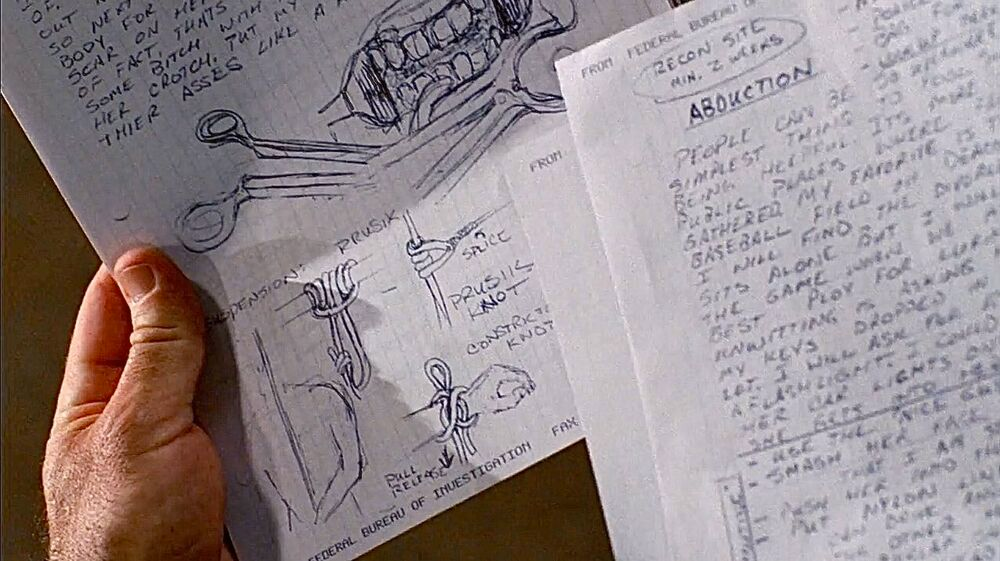Criminal Minds S03E13 “Limelight” Aired January 23, 2008 IMDB
Criminal Minds is a police procedural TV series focusing on a FBI unit of criminal profilers. Criminal profiling is a somewhat questionable methodology in reality.
Unlike a lot of other episodes in this type of show, this episode doesn’t begin with the discovery of a dead sex worker. An abandoned storage locker is opened to reveal a collection of bondage magazines, arty porn shots, and detailed journals about capturing and torturing women, complete with diagrams.

Local FBI agent Jill Morris (Andrea Roth) calls in the profilers and says they found “assorted artwork, torture porn, bondage, but what strikes me is the prose. It screams of high order sexual predator.”
Profiler agent Rossi says, “The materials are the product of a disturbed individual, but there’s nothing there to convince me that the person has enacted on these fantasies.” He adds that he has cases with actual bodies to consider.
This is when Morris shows him the were long blond hairs found in the locker, which is enough to call in the profiler unit. Rossi says, “We have to establish if this guy’s taking his fantasies to the next level. […] Find the fetish, find the fiend.”
The underlying assumption of the investigators in this episode is escalation, that a person with such fantasies will probably progress to acting them out nonconsensually. Earlier versions of the Diagnostic and Statistical Manual included this assumption in the listing for “sexual sadism,” without support. This is much like the “gateway drug” theory of drug abuse, now somewhat discredited.
Criminal Minds uses fantasy sequences to illustrate the agents’ reconstruction of the perpetrator. One of these sequences shows the unknown subject as a boy in his early teens finding a box of adult magazines in his father’s garage, and the narration describes this as “his turning point” that put him on the path towards being a serial killer. When you consider that, pre-Internet, most teenage or younger boys would have had their first encounter with pornography in this way, and only a small percentage of them grew up to be violent offenders, the idea of a causal relationship becomes implausible.
Agent Rossi mentions finding his own father’s collection of adult magazines (and presumably didn’t become a serial killer), but the escalation theory goes unquestioned.
Hotchner: “This guy graduated to harder stuff. The torture porn, it’s brutal.”
Rossi: “It brought out certain desires. The early exposure was a trigger. When I interviewed [Ted] Bundy, he had a theory about pornography. He said, ‘If you want to stop people from becoming like me, don’t burn Catcher in the Rye…’”
Hotchner: “‘Burn Hustler.’”
Further investigation of the locker reveals dresses altered to fit men’s bodies, which the agents say are a trophy collected by the (so far still hypothetical) killer.
More unsolved dead females turn up fitting the signature of upwardly mobile white women with electrical burns.
The agents’ briefing begins another fantasy sequence of the killer studying professional women.
Brunette female agent: “They’re attractive, professional women. He sees them as strong, righteous, unattainable.”
At this point, the fantasy of the killer and the brunette female agent are arranged as if they are making eye contact.
Brunette female agent: “So he seeks to tear them down. To reduce them to base, sexual creatures, and punish them.”
Hotchner: “He’s a true sexual sadist. A typology we refer to as ‘anger-excitation’, meaning he becomes sexually aroused by the suffering of his victims.”
Rossi: “Killing these women is an afterthought. Their pain is what he’s after. And he takes his time to exact maximum stimulation.”
[…]
Brunette female agent: “We believe he’s using them [the dresses] for rehearsal fantasies. By dressing as his victims he can relive the torture. It’s during this time that he most likely pleasures himself in order to reinforce his association between suffering and gratification.”
Hotchner: “And when he becomes dissatisfied with this, he seeks out a new victim.”
Rossi: “Keep in mind, he’s been doing this for a long time, and he’s been thinking about doing in for most of his life. He’ll continue to evolve, finding new ways of challenging himself and increasing his stimulation threshold. There are no boundaries for this man.”
This investigation is based on the worst kind of reasoning, cherry picking facts to fit a predetermined narrative that isn’t based on anything.
We find out that Morris planted her own hairs in the locker. It’s part of her plan to advance her career through association with a high-profile case. She even brainstorms media-friendly nicknames for the killer she is convinced exists, and stages a press conference.
This swamps the office with false leads, though one anonymous tip, actually from the killer, produces a couple of buried dead women.

At this point, all of this speculation becomes redundant as the killer deliberately leaves clues for the agents, “writing his own story” as one agent says. He even let the lease on the storage locker run out so it would be discovered. This implies that the pornography and other materials were selected by the killer to provoke an investigation, and may have had nothing to do with the killer’s earlier life. The killer is conforming to the mythologized narrative of “the serial killer”, and Morris is playing along. He’s acting the way a serial killer is supposed to act, the way Morris wants him to act. They’re caught in a perverse folie a deux.

This being fiction, the killer, when captured, perfectly fits the profile the agents concocted. “The whole profile’s here, in black and white,” says Hotchner. It’s easy to validate a method of investigation based on prejudiced assumptions when your opposition willingly conforms to them. That’s how the escalation theory of sexual sadism is perpetuated, and why it had to be removed from later editions of the DSM by the work of the National Coalition for Sexual Freedom.




I seem to recall that when I watched that episode I spent a lot of the hour yelling at the tv in frustration. Such an awful plot…